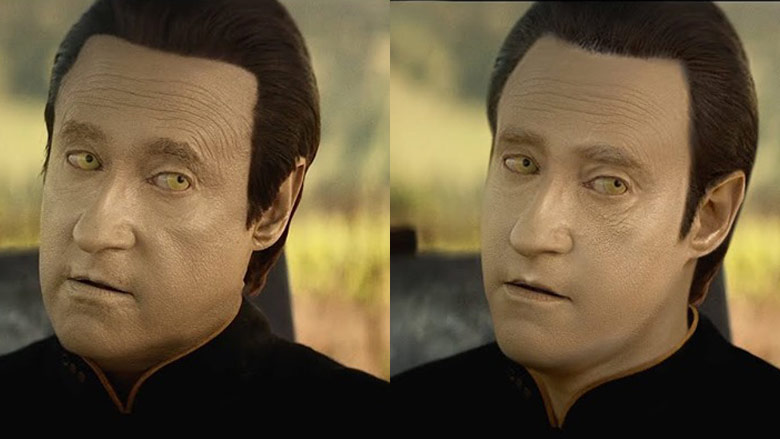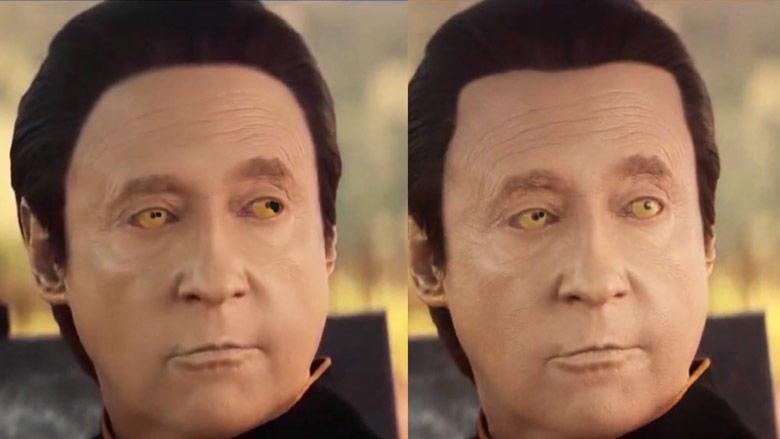
CBS CBS’s Data versus the version created by Sebastian Schmidt.
Revisiting a group of characters who appeared on television and film nearly 30 years ago is difficult. As James T. Kirk observed in “The Wrath of Khan,” aging is hard to ignore. This is especially true if an actor is recognized around the world for a role that they made famous.
This was the exact challenge that the producers of “Star Trek: Picard” faced. The show, which saw the return of Jean-Luc Picard, Commander Riker and Counselor Troi, did not ignore the many years that had passed since the end of their final on-screen story, which was “Star Trek: Nemesis.”
Patrick Stewart’s character had changed, he looked thinner and his voice cracked in a way that never happened on “The Next Generation.” Riker and Troi changed as well, but they still looked like the people that fans fell in love with back in 1987. This should be fine with everyone, as Picard, Riker and Troi are all humans (or half-human), and people age.
Things were different when it came to Brent Spiner’s character, Mr. Data. The android who wished he could be human was not supposed to age. In fact, in several TNG episodes, fans saw Data in the future — the episodes “Time’s Arrow” and “All Good Things…” are good examples of this.
So when it came time to include the ageless and fabricated Data into Picard’s dreams (and ultimately into a holo-reality in the final episode), things didn’t quite look right.
Original ‘Star Trek: Picard’ Trailer Sparked Immediate Discussion Among Fans
In the first trailer for “Picard,” which was unveiled during New York Comic Con 2019, fans immediately pointed out that something was off with Mr. Data. Specifically, it was his hairline. This was corrected for the series, and the strange hairline could be excused by the time constraints to get the trailer done for NYCC.

CBSThe original hairline (left) and the updated hairline (right).
In a piece for ComicBook.com, reporter Jamie Lovett wrote that Spiner was encouraged to return to the role of Data because of “new technology like the de-aging tech employed most famously in Marvel and Star Wars movies.”
In the article, Spiner said that he was reluctant to reprise the role because he “just didn’t know if it could be believable, as far as believing an android.”
His appearance in the trailer led some fans to discuss on Reddit precisely what — if any — de-aging or CGI the producers of “Picard” used to make Spiner look younger. Even though the team at “Picard” were honored with an Emmy Award for “Outstanding Prosthetic Makeup For A Series,” people still grumbled about a number of things, including the aged android.
Not The First Time De-Aging Backfired
Though it was not for his role in “Star Trek,” Patrick Stewart has had his fair share of de-aging miscues. Most notably, in his role of Professor Charles Xavier in “X-Men: The Last Stand,” Stewart went through a de-aging process that some called “uncomfortable.”
This was actually a breakthrough moment for Hollywood, as it was the first use of CGI de-aging for a major studio. Both Stewart and Ian McKellen (Magneto) were de-aged for a critical scene in the film.
De-Aging, German-Style
While some fans have puzzled over the decision to not fully de-age Spiner for ”Picard,” others have done something about it. Sebastian Schmidt, who hails from Potsdam, Germany, recently released his version of what could have been. The Data shown in Schmidt’s version looks very much like the Data fans last saw in “Nemesis.”
Schmidt said that he was motivated to update the scene for a simple reason.
“People age, while androids do not,” said Schmidt. “The return of Brent Spiner in ‘Picard’ was brilliant! Data is such an iconic character, and I really enjoyed his scenes with Patrick Stewart.”
“Data’s look felt off to me,” Schmidt continued. “It was not just his age, his hair, his eyes … it just didn’t look right. So, I decided to give him a visual update. I would have been OK with an old version [of] Data, but that was not the direction the creators were aiming for.”
Schmidt said that it was a long and tedious process with lots of trial and error, but he altered Mr. Data’s look mostly with Adobe After Effects.
“It’s basically just a very complex 2D composite in After Effects,” Schmidt said. “I moved some parts of his face, used frequency separation to de-age his skin, and darkened his eyes.”
“I also used some low-resolution deepfakes as base and guideline,” Schmidt added. “I had to do a lot of work in Photoshop to create some additional keyframes. I later created image sequences from these keyframes with a software called EbSynth.”
Schmidt also created an animation of the U.S.S. Zheng He, which was commanded by Riker in the final episode of “Picard.”
“I always felt this particular model from ‘Star Trek: Picard’ needed some more attention,” Schmidt said.
Data in ‘Picard’ Season 2
Since fans are aware that Data will return (somehow) for Season 2 of ‘Picard,’ perhaps the producers will give Sebastian Schmidt a call for some de-aging assistance. If not for Data (or B4), then perhaps Q (John de Lancie) could use a little CGI. If androids aren’t supposed to age, then neither are omnipotent beings.
READ NEXT: How One of the Worst ‘Star Trek’ Films Became Its Most Significant
